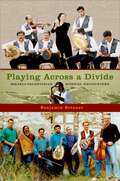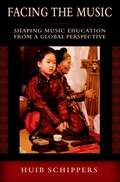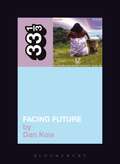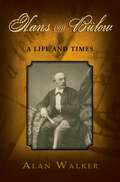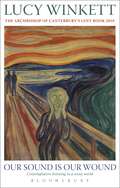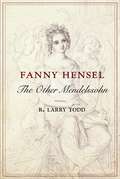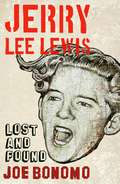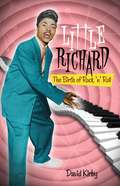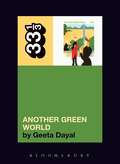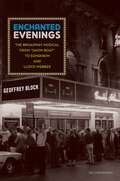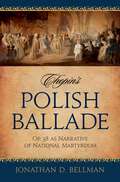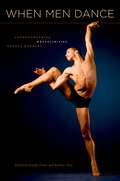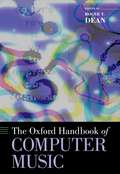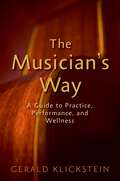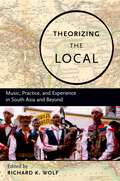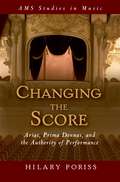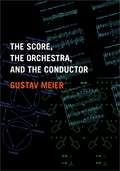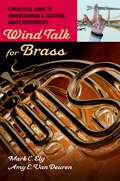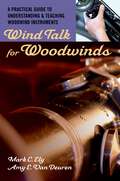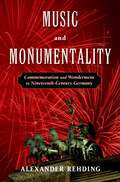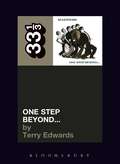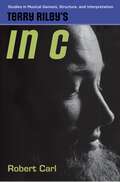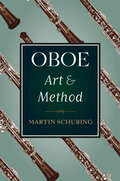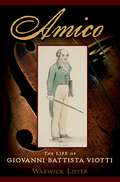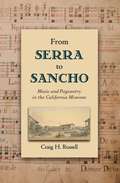- Table View
- List View
Playing across a Divide: Israeli-Palestinian Musical Encounters
by Benjamin BrinnerIn the last decade of the twentieth century and on into the twenty-first, Israelis and Palestinians saw the signing of the Oslo Peace Accords, the establishment of the Palestinian Authority, the assassination of Israeli Prime Minister Yitzhak Rabin, and the escalation of suicide bombings and retaliations in the region. During this tumultuous time, numerous collaborations between Israeli and Palestinian musicians coalesced into a significant musical scene informed by these extremes of hope and despair on both national and personal levels. Following the bands Bustan Abraham and Alei Hazayit from their creation and throughout their careers, as well as the collaborative projects of Israeli artist Yair Dalal, Playing Across a Divide demonstrates the possibility of musical alternatives to violent conflict and hatred in an intensely contested, multicultural environment. These artists' music drew from Western, Middle Eastern, Central Asian, and Afro-diasporic musical practices, bridging differences and finding innovative solutions to the problems inherent in combining disparate musical styles and sources. Creating this new music brought to the forefront the musicians' contrasting assumptions about sound production, melody, rhythm, hybridity, ensemble interaction, and improvisation. Author Benjamin Brinner traces the tightly interconnected field of musicians and the people and institutions that supported them as they and their music circulated within the region and along international circuits. Brinner argues that the linking of Jewish and Arab musicians' networks, the creation of new musical means of expression, and the repeated enactment of culturally productive musical alliances provide a unique model for mutually respectful and beneficial coexistence in a chronically disputed land.
Facing the Music: Shaping Music Education from a Global Perspective
by Huib SchippersFacing the Music investigates the practices and ideas that have grown from some five decades of cultural diversity in music education, developments in ethnomusicology, and the rise of 'world music'. Speaking from rich, hands-on experience of more than thirty years at various levels of music education (music in schools, community organizations and professional training courses), Huib Schippers makes a powerful case for the crucial role of learning music in shaping rich and diverse musical environments for the 21st century, both in practical terms and at a conceptual level: "what we hear is the product of what we believe about music." Advocating a contemporary, positive and realistic approach to cultural diversity in music education and transmission, Schippers advocates taking into account and celebrating the natural dynamics of music. He argues that "most music travels remarkably well", and regards every musical act as an expression of the 'here and now', as do many of the musicians and scholars he quotes. In this way, he challenges stifling directives to recreate 'authentic contexts', which in fact constantly change (and have always changed) in the cultures of origin as well. This liberates music educators to seek with integrity appropriate ways of presenting music at all levels of education: in schools, community settings, and professional training. In seven succinct chapters that each approach the issues from a different angle, Schippers gradually unfolds the complexities of learning and teaching music 'out of context' in an accessible manner, and presents a coherent model to approach these, as well as lucid suggestions for translating the resulting ideas in practice. While mapping the various factors that determine all acts of music transmission, he also comes to surprising insights into the nature and preconceptions underlying much formal music education settings across the world, including those focusing on western classical music. Facing the Music provides a rich resource for reflection and practice for all those involved in teaching and learning music, from policy maker to classroom teacher.
Israel Kamakawiwo'ole's Facing Future (33 1/3)
by Dan KoisEven at four in the morning, the strip clubs and watering holes surrounding the Honolulu studio were still hopping. The recording engineer heard a car pull into the lot, and soon the biggest man he had ever seen walked in. When he stepped into the studio, the floated floor shifted beneath the engineer's feet. Israel Kamakawiwo'ole engulfed the engineer's hand in his and said, "Hi, bruddah." The product of that impromptu recording session, a delicate medley of "Somewhere Over the Rainbow" and "What a Wonderful World," has driven sales of Facing Future to nearly two million copies. Each time the medley is licensed to appear in advertisements, in movies, even on American Idol, Mainlanders embrace it anew as a touch of the unfamiliar in their otherwise staid record collections. But in Hawai'i, a state struggling with the responsibility of its native heritage, Facing Future is much more. Gaining unprecedented access to Israel's family, friends, and colleagues, Dan Kois tells the remarkable story of Bruddah Iz and the album that changed his life-and his death.
Hans Von Bülow: A Life and Times
by Alan WalkerHans von Bülow is a key figure in 19th century music whose career path was as broad as it was successful. Music history's first virtuoso orchestral conductor, Bülow created the model for the profession-both in musical brilliance and in domineering personality-which still holds forth today. He was an eminent and renowned concert pianist, a respected (and often feared) teacher and music critic, an influential editor of works by Bach, Mendelssohn, Chopin, and Beethoven, and a composer in a variety of musical genres. As a student and son-in-law of Franz Liszt, and estranged friend of Richard Wagner (for whom his wife Cosima famously left him), Bülow is intricately connected with the canonical greats of the period. Yet despite his critical and lasting importance for orchestral music, Bülow's life and significant achievements have yet to be heralded in biographical form. In Hans von Bülow: A Life and Times, Alan Walker, the acclaimed author of numerous award-winning books on the era's iconic composers, provides the first full-length English biography of this remarkable musical figure. Walker traces Bülow's life in illuminating and engaging detail, from the first piano lessons of his boyhood days, to his first American tour, to his last days as conductor of the Berlin Philharmonic. Unearthing Bülow's extensive and previously unavailable correspondence and writings, Walker conveys amusing and informative anecdotes about this unique musical legend- from his sardonic and clever personality to his meticulous devotion to his work-and reveals enlightening insights on the still-contested sensibilities of musical-compositional style and "idea" at play in the vibrant musical world of which Bülowwas a part.
Our Sound is Our Wound: Contemplative Listening to a Noisy World -- The Archbishop of Canterbury's Lent Book 2010
by Lucy WinkettThis book is a meditation on how we listen for the voice of God within the soundscapes of our lives, and how we find our own voice.
Fanny Hensel: The Other Mendelssohn
by R. Larry ToddGranddaughter of the philosopher Moses Mendelssohn and sister of the composer Felix Mendelssohn Bartholdy, Fanny Hensel (1805-1847) was an extraordinary musician who left well over four hundred compositions, most of which fell into oblivion until their rediscovery late in the twentieth century. In Fanny Hensel: The Other Mendelssohn, R. Larry Todd offers a compelling, authoritative account of Hensel's life and music, and her struggle to emerge as a publicly recognized composer.
Jerry Lee Lewis: Lost and Found
by Joe BonomoA superb new study of Jerry Lee Lewis that's as intense and fast paced as the life of "The Killer" himself, from the height of fame to the bumpy road that followed"The category in which Jerry Lee Lewis truly belongs is 'Jerry Lee Lewis.' The Killer is as big as Mount Rushmore, and he's also as American, as revered, as clichéd, as misunderstood, as corny, and as taken for granted as that monument. The curse of iconoclastic American success. Elvis felt it, so does Dylan. So will others who haven't been born yet."The story of Louisiana hellcat Jerry Lee Lewis and his 1958 wedding scandal-it was discovered that at 22 he had married his 13-year old second cousin, Myra, before he was divorced from his second wife-long ago took precedence over the man himself and the music he makes. In Jerry Lee Lewis: Lost and Found, author Joe Bonomo lets others focus on the scandal and delves more deeply into the accidental intersection between fading American Rockabilly and ascending Beatlemania. By first taking a look at the critical years before his famed night in 1964 at West Germany's Star-Club - what that meant not only for him but the entire live album-making world - then the tumultuous years that follow, culminating in his time on the American Country charts in the late 60s/ early 70s, Bonomo brings Jerry Lee Lewis to life in new and fascinating ways.In spite of plummeting record sales and concert fees, a media savaging of his personal character, a change of record labels and management, and a considerable upturn in his drug and alcohol abuse, Jerry Lee Lewis has persevered. In between being betrayed and ignored, he would record one of the greatest rock & roll performances in history. Bonomo's thorough research includes new interviews with Live at the Star-Club producer Sigi Loch, members of the Nashville Teens, and other musicians and fans who were at the Star-Club performance, as well as with music industry figures ranging from famed Nashville producer Jerry Kennedy and legendary Memphis stalwart Jim Dickinson to Killer-influenced contemporaries John Doe and Dave Alvin. This passionate book examines and explains the almighty impact of the Father of Rock'n'Roll.
Little Richard: The Birth of Rock 'n' Roll
by David KirbyA brilliant new biography of the extraordinary, outrageous performer who helped open the floodgates of Rock 'n' Roll. In June, 2007, Little Richard's 1955 Specialty Records single, "Tutti Frutti," topped Mojo magazine's list of "100 Records That Changed the World." But back in the early 1950s, nobody gave Little Richard a second glance. It was a time in America where the black and white worlds had co-existed separately for nearly two centuries. After "Tutti Frutti," Little Richard began garnering fans from both sides of the civil rights divide. He brought black and white youngsters together on the dance floor and even helped to transform race relations.Little Richard: The Birth of Rock 'n' Roll begins by grounding the reader in the fertile soil from which Little Richard's music sprang. In Macon, Georgia, David Kirby interviews relatives and local characters, who knew Little Richard way back when, citing church and family as his true inspiration. His antics began as early as grade school, performing for his classmates every time the teacher would leave the room, connecting to an age-old American show biz tradition of charade and flummery. On the road, Little Richard faced competition from his peers, honing his stage show and making it, too, an act that could not be counterfeited.Kirby sees Little Richard as a foxy warrior, fighting with skill and cunning to take his place among the greats. In the words of Keith Richards (on hearing "Tutti Frutti" for the first time), "it was as though the world changed suddenly from monochrome to Technicolor." Those sentiments have consistently been echoed by the music-listening world, and the time is ripe for a reassessment of Little Richard's genius and legacy.
Brian Eno's Another Green World (33 1/3)
by Geeta DayalThe serene, delicate songs on Another Green World sound practicallymeditative, but the album itself was an experiment fueled byadrenaline, panic, and pure faith. It was the first Brian Eno album tobe composed almost completely in the confines of a recording studio,over a scant few months in the summer of 1975. The album was a proofof concept for Eno's budding ideas of "the studio as musicalinstrument," and a signpost for a bold new way of thinking aboutmusic.In this book, Geeta Dayal unravels Another Green World's abundantmysteries, venturing into its dense thickets of sound. How was analbum this cohesive and refined formed in such a seemingly ad hoc way?How were electronics and layers of synthetic treatments used to createan album so redolent of the natural world? How did a deck of cardsfigure into all of this? Here, through interviews and archivalresearch, she unearths the strange story of how Another Green Worldformed the link to Eno's future -- foreshadowing his metamorphosisfrom unlikely glam rocker to sonic painter and producer.
Enchanted Evenings: The Broadway Musical from 'Show Boat' to Sondheim and Lloyd Webber
by Geoffrey BlockThis new second edition of Enchanted Evenings offers theater lovers an illuminating behind-the-scenes tour of some of America's best loved, most admired, and most enduring musicals. Readers will find such all-time favorites as Show Boat, Carousel, Kiss Me, Kate, Guys and Dolls, My Fair Lady, West Side Story, Sweeney Todd, Sunday in the Park with George, and Phantom of the Opera. Geoffrey Block provides a documentary history of each of the musicals, showing how each work took shape and revealing, at the same time, how the American musical evolved from the 1920s to today, both on stage and on screen. The book's particular focus is on the music, offering a wealth of detail about how librettist, lyricist, composer, and director work together to shape the piece. Block also includes trenchant social commentary and lively backstage anecdotes. Jerome Kern, Cole Porter, the Gershwins, Rodgers and Hart, Kurt Weill, Rodgers and Hammerstein, Lerner and Loewe, Frank Loesser, Leonard Bernstein, Stephen Sondheim, Andrew Lloyd Webber, and other luminaries emerge as hardworking craftsmen under enormous pressure to sell tickets without compromising their dramatic vision. The second edition includes a greatly expanded chapter on Sondheim, a new chapter on Lloyd Webber, and two new chapters on the film adaptations of the main musicals featured in the text (including such hard to find films as the original 1936 version of Anything Goes and the 1959 film adaptation of Porgy and Bess). Packed with information, including a complete discography and plot synopses and song-by-song scenic outlines for each of the fourteen shows, Enchanted Evenings is an essential reference as well as a riveting history. "A solid and fascinating work that should become a model of how to investigate and report on the evolution of a musical. Block's research is persuasive and his writing vivid. . . Indispensable for anyone who cares to know more about Broadway musicals than Playbill can provide." --Steven Bach, The Los Angeles Times Book Review
Chopin's Polish Ballade: Op. 38 as Narrative of National Martyrdom
by Jonathan D. BellmanChopin's Polish Ballade examines the Second Ballade, Op. 38, and how that work gave voice to the Polish cultural preoccupations of the 1830s, using musical conventions from French opera and amateur piano music. This approach provides answers to several persistent questions about the work's form, programmatic content, and poetic inspiration.
When Men Dance: Choreographing Masculinities Across Borders
by Jennifer Fisher Anthony ShayWhen Men Dance explores the intersection of dance and perceptions of male gender and sexuality across history and different cultural contexts. Chapters tackle the history and dilemmas that revolve around dance and notions of masculinity from a variety of dance studies perspectives, and are accompanied by fascinating personal histories that complement their themes.
The Oxford Handbook of Computer Music (Oxford Handbooks)
The Oxford Handbook of Computer Music offers a state-of-the-art cross-section of the most field-defining topics and debates in computer music today. A unique contribution to the field, it situates computer music in the broad context of its creation and performance across the range of issues - from music cognition to pedagogy to sociocultural topics - that shape contemporary discourse in the field. Fifty years after musical tones were produced on a computer for the first time, developments in laptop computing have brought computer music within reach of all listeners and composers. Production and distribution of computer music have grown tremendously as a result, and the time is right for this survey of computer music in its cultural contexts. An impressive and international array of music creators and academics discuss computer music's history, present, and future with a wide perspective, including composition, improvisation, interactive performance, spatialization, sound synthesis, sonification, and modeling. Throughout, they merge practice with theory to offer a fascinating look into computer music's possibilities and enduring appeal.
The Musician's Way: A Guide to Practice, Performance, and Wellness
by Gerald KlicksteinIn The Musician's Way, veteran performer and educator Gerald Klickstein combines the latest research with his 30 years of professional experience to provide aspiring musicians with a roadmap to artistic excellence. Part I, Artful Practice, describes strategies to interpret and memorize compositions, fuel motivation, collaborate, and more. Part II, Fearless Performance, lifts the lid on the hidden causes of nervousness and shows how musicians can become confident performers. Part III, Lifelong Creativity, surveys tactics to prevent music-related injuries and equips musicians to tap their own innate creativity. Written in a conversational style, The Musician's Way presents an inclusive system for all instrumentalists and vocalists to advance their musical abilities and succeed as performing artists.
Theorizing the Local: Music, Practice, and Experience in South Asia and Beyond
by Richard WolfOver the past four decades, the "globalized" aspects of cultural circulation have received the majority of scholarly-and consumer-attention, particularly in the study of South Asian music. As a result, a broad range of community-based and other locally focused performance traditions in the regions of South Asia have remained relatively unexplored. Theorizing the Local provides a challenging and compelling counterperspective to the "globalized," arguing for the value of comparative microstudies that are not concerned primarily with the flow of capital and neoliberal politics. What does it mean for musical activities to be local in an increasingly interconnected world? To what extent can theoretical activity be localized to the very acts of making music, interacting, and composing? Theorizing the Local offers glimpses into rich musical worlds of south and west Asia, worlds which have never before been presented in a single volume. The authors cross the traditional borders of scholarship and region, exploring in unmatched detail a vast array of musical practices and significant ethnographic discoveries-from Nepal to India, India to Sri Lanka, Pakistan to Iran. Enriched by audio and video tracks on an extensive companion Web site, Theorizing the Local is an important study of South Asian musical traditions that offers a broader understanding of 21st-century music of the world.
Changing the Score: Arias, Prima Donnas, and the Authority of Performance (AMS Studies in Music)
by Hilary PorissThis study seeks to explore the role and significance of aria insertion, the practice that allowed singers to introduce music of their own choice into productions of Italian operas. Each chapter investigates the art of aria insertion during the nineteenth century from varying perspectives, beginning with an overview of the changing fortunes of the practice, followed by explorations of individual prima donnas and their relationship with particular insertion arias: Carolina Ungher's difficulties in finding a "perfect" aria to introduce into Donizetti's Marino Faliero; Guiditta Pasta's performance of an aria from Pacini's Niobe in a variety of operas, and the subsequent fortunes of that particular aria; Maria Malibran's interpolation of Vaccai's final scene from Giulietta e Romeo in place of Bellini's original setting in his I Capuleti e i Montecchi; and Adelina Patti's "mini-concerts" in the lesson scene of Il barbiere di Siviglia. The final chapter provides a treatment of a short story, "Memoir of a Song," narrated by none other than an insertion aria itself, and the volume concludes with an appendix containing the first modern edition of this short story, a narrative that has lain utterly forgotten since its publication in 1849. This book covers a wide variety of material that will be of interest to opera scholars and opera lovers alike, touching on the fluidity of the operatic work, on the reception of the singers, and on the shifting and hardening aesthetics of music criticism through the period.
The Score, the Orchestra, and the Conductor
by Gustav MeierKnown internationally for his work as a teacher of conducting, Gustav Meier's influence in the field cannot be overstated. In The Score, the Orchestra and the Conductor, Meier demystifies the conductor's craft with explanations and illustrations of what the conductor must know to attain podium success. He provides useful information from the rudimentary to the sophisticated, and offers specific and readily applicable advice for technical and musical matters essential to the conductor's first rehearsal with the orchestra. This book details many topics that otherwise are unavailable to the aspiring and established conductor, including the use of the common denominator, the "The ZIG-ZAG method", a multiple, cross-indexed glossary of orchestral instruments in four languages, an illustrated description of string harmonics, and a comprehensive listing of voice categories, their overlaps, dynamic ranges and repertory. The Score, the Orchestra and the Conductor is an indispensable addition to the library of every conductor and conducting student.
Wind Talk for Brass: A Practical Guide to Understanding and Teaching Brass Instruments
by Mark C. Ely Amy E. Van DeurenWind Talk for Brass provides instrumental music teachers, practitioners, and students with a handy, easy-to-use pedagogical resource for brass instruments found in school instrumental programs. With thorough coverage of the most common brass instruments - trumpet, horn, trombone, baritone/euphonium, and tuba/sousaphone - the book offers the most topical and information necessary for effective teaching. This includes terminology, topics, and concepts associated with each specific instrument, along with teaching suggestions that can be applied in the classroom. Be sure to look to the back of the book for a "Practical Tips" section, which discusses common technical faults and corrections, common problems with sound (as well as their causes and solutions to them), fingering charts, literature lists (study materials, method books, and solos), as well as a list of additional resources relevant to teaching brass instruments (articles, websites, audio recordings). Without question, Wind Talk for Brass stands alone as an invaluable resource for woodwinds!
Wind Talk for Woodwinds: A Practical Guide to Understanding and Teaching Woodwind Instruments
by Mark C. Ely Amy E. Van DeurenWind Talk for Woodwinds provides instrumental music teachers, practitioners, and students with a handy, easy-to-use pedagogical resource for woodwind instruments found in school instrumental programs. With thorough coverage of the most common woodwind instruments - flute, oboe, clarinet, saxophone, and bassoon - the book offers the most topical and information necessary for effective teaching. This includes terminology, topics, and concepts associated with each specific instrument, along with teaching suggestions that can be applied in the classroom. Be sure to look to the back of the book for a "Practical Tips" section, which discusses common technical faults and corrections, common problems with sound (as well as their causes and solutions to them), fingering charts, literature lists (study materials, method books, and solos), as well as a list of additional resources relevant to teaching woodwind instruments (articles, websites, audio recordings). Without question, Wind Talk for Woodwinds stands alone as an invaluable resource for woodwinds!
Music and Monumentality: Commemoration and Wonderment in Nineteenth Century Germany
by Alexander RehdingThis critical study locates musical monumentality, a central property of the nineteenth-century German repertoire, at the intersections of aesthetics and memory. In examples including Beethoven, Liszt, Wagner and Bruckner, Rehding explores how monumentality contributes to an experiential music history and how it conveys the sublime to the listening public.
Madness' One Step Beyond... (33 1/3)
by Terry EdwardsOne Step Beyond isn't the best album in the world - it's not even the best album by Madness. It is, however, a great record and an exceptional debut album -fully formed despite half the band still being in their teens - and it remains as exhilarating, inspiring and as much fun as when people first heard it nearly 30 years ago. Through extensive interviews with the band, as well as producers Clive Langer & Alan Winstanley, Terry Edwards tells the inside story of how Madness rose to be the most successful singles band of the 1980s in the UK charts.
Terry Riley's In C (Studies in Musical Genesis, Structure, and Interpretation)
by Robert CarlSetting the stage for a most intriguing journey into the world of minimalism, Robert Carl's Terry Riley's In C argues that the work holds its place in the canon because of the very challenges it presents to "classical" music. Carl examines In C in the context of its era, its grounding in aesthetic practices and assumptions, its process of composition, presentation, recording, and dissemination.
Oboe Art and Method
by Martin SchuringIn Oboe Art and Method, veteran oboe performer and instructor Martin Schuring describes in detail all of the basic techniques of oboe playing and reed making, with expert tips and step-by-step instructions for how best to perform each of these tasks with grace and technical efficiency. Schuring's straightforward and articulate explanations of breathing, embouchure, finger technique, articulation, phrasing, and more help demystify the earliest stages of oboe playing and beyond. In addition, Schuring provides excellent advice on the "extra-musical"; practicing, instrument care and adjustment, professional development, and career development-related issues. The oboe is a notoriously complicated instrument, and this book aims to remove as much of the complexity as possible, to present techniques that work, and to discuss these in a clear-cut manner. Students who start with this book will learn with confidence that these methods will steer them straight down an effective path. A concise and eminently useful guide, Oboe Art and Method is a must-have for all who perform, teach, or are learning to play the oboe, in both conservatories and private instruction.
Amico: The Life of Giovanni Battista Viotti
by Warwick ListerThis is the first full-length biography in English of Giovanni Battista Viotti (1755-1824), one of the great violinist-composers in the history of music, and arguably the most influential violinist who ever lived. This study is based on extensive documentary research, much of it here revealed for the first time.
From Serra to Sancho: Music and Pageantry in the California Missions (Currents in Latin American and Iberian Music)
by Craig H. RussellMusic in the California missions was a pluralistic combination of voices and instruments, of liturgy and spectacle, of styles and functions--and even of cultures--in a new blend that was non-existent before the Franciscan friars made their way to California beginning in 1769. From Serra to Sancho explores the exquisite sacred music that flourished on the West Coast of the United States when it was under Spanish and Mexican rule, delving into the historical, cultural, biographical, and stylistic aspects of California mission music during the late eighteenth and early nineteenth centuries. Author Craig H. Russell examines how mellifluous plainchant, reverent hymns, spunky folkloric ditties, "classical" music in the style of Haydn, and even Native American drumming were interwoven into a tapestry of resonant beauty. In addition to extensive musical and cultural analysis, Russell draws upon hundreds of primary documents in California, Mexico, Madrid, Barcelona, London, and Mallorca. It is through the melding together of this information from geographically separated places that he brings the mystery of California's mission music into sharper focus. Russell's groundbreaking study sheds new light on the cultural exchange that took place in the colonial United States, as well as on the pervasive worldwide influence of Iberian music as a whole.
